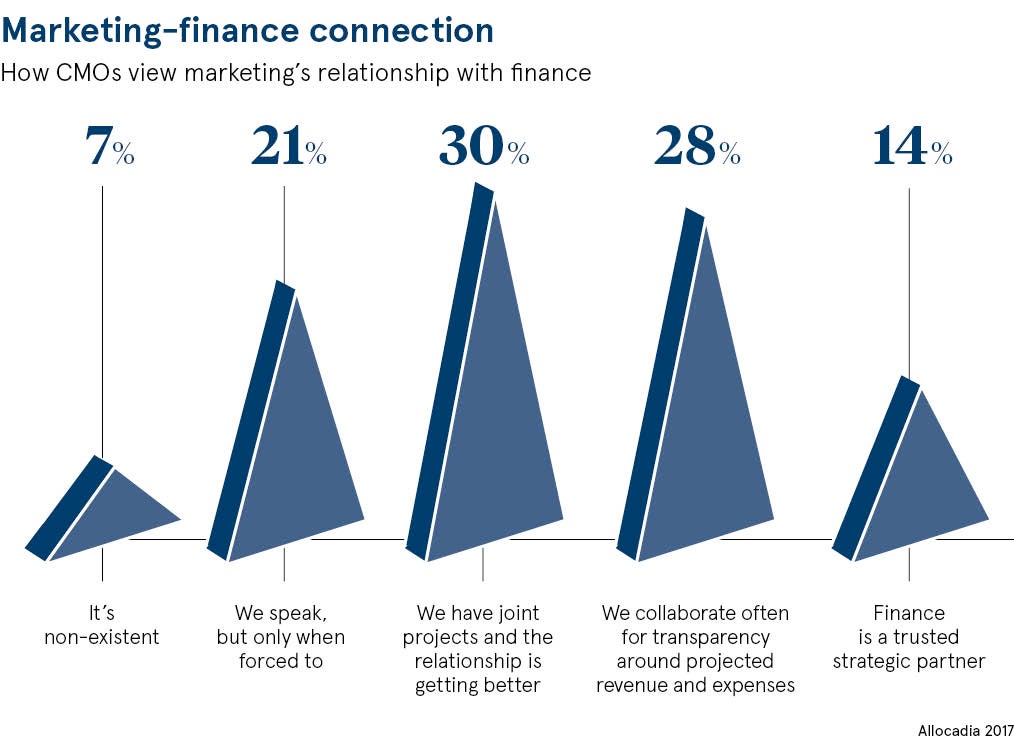Rewind a bit in corporate history; those who held the strings to the company purse and those who liked to raid it, particularly marketing, were not best bosom buddies. Prone to conflict over budgets, the chief financial officer (CFO) always demanded numbers, while the chief marketing officer (CMO) perennially pushed wishy-washy, discretionary spend, which evaporated in exchange for a sniff of business goodwill.
Static, mono-dimensional roles create friction, while siloes kill progress within organisations
“The pressure has been building for years, but we’re now seeing unprecedented urgency from business leaders to finally get a clear answer on marketing’s value,” explains Mark Stouse, chief executive of Proof Analytics.
This is why 21st-century marketing is increasingly about metrics. Reams of data, sophisticated analytics and digital tools are all combined, along with the rise of ecommerce. In the process, it has become more of a science than an art. Campaigns are more measurable, the CFO-CMO drama is now less a Clash of the Titans and more Love Actually.
Collaboration increases with marketing’s focus on revenue
“Today, if CMOs don’t stand for revenue, they stand for nothing,” explains Thomas Barta, CMO expert and co-author of The 12 Powers of a Marketing Leader. A few years back an EY survey highlighted that this relationship was evolving. The majority of 650-plus CFOs polled said their collaboration with the CMO and their department was on the rise.
With the cost-discipline lens firmly aimed at campaigns, there are still questions on whether there’s been a shift to a value-driven mindset. Certainly, there’s been greater outlay from finance bosses on more quantifiable projects.
“The big growth in marketing spend is on digital activities with measurable short-term results; that’s great unless it leads to short-termism. Longer-term strategies will always be more of an art than a science,” says Patrick Barwise, emeritus professor of management and marketing at the London Business School and co-author with Mr Barta.
“Most CFOs understand that some things are easier to quantify than others, but they do like evidence and logic. A CMO who wants to invest in long-term brand-building should explain the underlying thinking to the CFO, not just assume that he or she won’t understand. But the evidence will need to be convincing.”
Finance and marketing need a common toolkit
The key message for marketing is that if you want budget support, then finance is the common language you need to speak. If CMOs can be more data driven when it comes to proving return on investment (RoI), and CFOs can provide forecasting and insight into the best way to spend marketing budgets, the partnership is more likely to flourish.
“It’s a two-way street. This isn’t necessarily plain sailing as it means fluid and regular communication between both departments. This involves identifying and bridging any cultural gaps so they are both aligned,” says Chris Coe, partner at Talentmark.
However, these two business functions still lack a common toolkit and key performance indicators. The gap could also be widening with the introduction of more complex digital marketing tools that finance teams are not familiar with.
“Some organisations have addressed the challenge by asking those in senior roles to help marketing and finance teams communicate; for instance, by creating a senior director in marketing finance. While other companies, particular in consumer-facing sectors, have created marketing excellence teams, which bring together those in marketing, finance and data science,” says Michael Haupt, digital finance consulting leader at Deloitte.
It’s also why the US CMO Council is calling on industry to develop more financial impact analytics to prove once and for all the discipline’s contribution to a business in real money terms.
“This will lead to greater precision, predictability and RoI. Most notably, we need to know how marketing contributes to revenue, margin, account profitability and deal value,” explains Donovan Neale-May, executive director at the CMO Council.

CFOs and CMOs need to work together to build strategy
Potentially, a different approach could also be needed. “Too many CMOs are trying to prove returns to their CFO, instead of working with the CFO to make the marketing case,” says Mr Barta. Those finance bosses who work hand in glove with gurus have the potential to generate better results, but only if there is a relationship recalibration.
“When CFOs and CMOs leave the rigid attachment associated with their specific role and become business partners, then you have a successful relationship. When the CFO and CMO can find a common goal in achieving success then they both win,” says Barbara Cichello, global director of marketing at LiveArea.
“The future will see the redefinition of these titles. Static, mono-dimensional roles create friction, while siloes kill progress within organisations. You need individuals who have an interest in understanding other disciplines. The CFO who really understands marketing will be the best ally of the CMO and the CMO who comprehends the business will find no friction with their CFO.”
It doesn’t help that it is one of the most expensive investments CFOs shell out on, yet it can be the most important in a company’s growth. There’s now increasing recognition that both short-term sales and marketing, as well as longer-term brand value, depend on a customers’ total experience of the company and its products.
“This recognition creates the need for better collaboration between disciplines, including marketing and finance; it’s called the value creation zone, or V zone, the overlap between the customers’ needs and the company’s needs. Long-term success comes from maximising this,” says Professor Barwise. Maybe it’s time CFOs focused on the V zone. CMOs will be happier.
Collaboration increases with marketing's focus on revenue
Finance and marketing need a common toolkit






